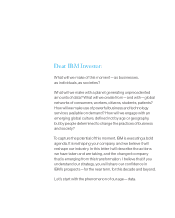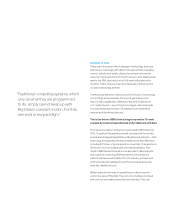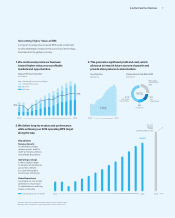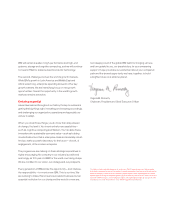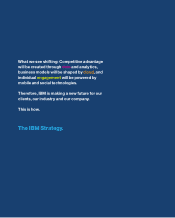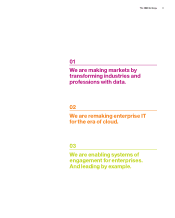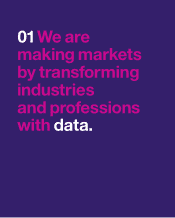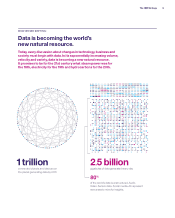IBM 2013 Annual Report Download - page 4
Download and view the complete annual report
Please find page 4 of the 2013 IBM annual report below. You can navigate through the pages in the report by either clicking on the pages listed below, or by using the keyword search tool below to find specific information within the annual report.apply a range of analytics—from descriptive to predictive to
prescriptive. And importantly, they can capture the time value of
data. This matters, because the battle for competitive advantage
in this new world can be lost or won in fractions of a second.
Our data and analytics portfolio today is the deepest in the
industry. It includes decision management, content analytics,
planning and forecasting, discovery and exploration, business
intelligence, predictive analytics, data and content management,
stream computing, data warehousing, information integration
and governance.
This portfolio provides the basis for the next major era in
computing—cognitive systems. Traditional computing systems,
which only do what they are programmed to do, simply cannot
keep up with Big Data in constant motion. For that, we need a new
paradigm. These new systems are not programmed; rather, they
learn, from the vast quantities of information they ingest, from their
own experiences, and from their interactions with people.
IBM launched this era three years ago, when our Watson system
defeated the two all-time champions on the quiz show Jeopardy!
Watson has since matured from a research grand challenge
into a multifaceted business platform, enabled globally via the
cloud. Earlier this year we launched the IBM Watson Group.
It will comprise 2,000 professionals, a $1 billion investment and
an ecosystem of partners and developers that we expect to
scale rapidly. In the process, we believe Watson will change
the nature of computing, as it is already beginning to change
the practice of healthcare, retail, travel, banking and more.
Taken together, our investments in data and analytics are driving
significant growth, with 40,000 service engagements to date,
growing by double digits. In 2013 our business analytics revenue
rose 9 percent—led by Global Business Services and Software.
This is already a nearly $16 billion business for us, and we have
raised our expectations for it.
An IT industry remade by cloud
At the same time that industries and professions are being remade
by data, the information technology infrastructure of the world is
being transformed by the emergence of cloud computing—that
is, the delivery of IT and business processes as digital services.
It is estimated that by 2016, more than one-fourth of the world’s
applications will be available in the cloud, and 85 percent of new
software is now being built for cloud.
This is driving IBM’s second strategic imperative: To remake
enterprise IT infrastructure for the era of cloud.
As important as cloud is, its economic significance is often
misunderstood. That lies less in the technology, which is relatively
straightforward, than in the new business models cloud will
enable for enterprises and institutions. This is creating a market
that is expected to reach $250 billion by 2015.
IBM today is the leader in enterprise cloud, a position we have
enhanced through investments of $7 billion on 15 acquisitions,
most notably SoftLayer in 2013. We provide the full spectrum of
cloud delivery models—infrastructure as a service, platform as a
service, software as a service and business process as a service.
IBM’s cloud capabilities are built on 1,500 cloud patents and
supported by thousands of cloud experts. Eighty percent of
Fortune 500 companies use IBM’s cloud capabilities.
Our cloud foundation at the infrastructure level is SoftLayer, the
market’s premier public and private cloud environment, with “bare
metal” dedicated servers that provide unmatched compute power,


